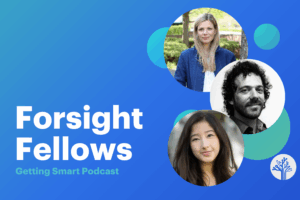From Readiness to Relevance: 3 Ways to Transform Career Connected Learning
Key Points
-
Career-connected learning must start early and be integrated across K–12 to provide students with exposure and informed choices for their futures.
-
Real-world, immersive learning experiences enhance student engagement and help build critical skills, social capital, and opportunities for success.

By: Dr. Mahnaz R. Charania
This past spring, as another high school graduating class crossed the stage—caps tossed high, hopes even higher—one hard truth hovered in the air: too many young people still feel unprepared for what’s next.
Recent data paints a stark picture: According to YouScience, nearly 72% of high school graduates (Classes of 2021–24) reported feeling only moderately, slightly, or not at all prepared for life after high school. This year, Gallup, the Walton Family Foundation, and Jobs for the Future (JFF) found that fewer than 30% of Gen Z high school students feel “very prepared” to pursue any post-high school pathway. Even among those most interested in one option, less than half feel very prepared. And among this year’s college graduates, just 24% believe they left with all the skills needed to succeed.
With everything from advances in AI to economic uncertainty, the world of work is shifting faster than ever, with careers morphing overnight, college becoming an uncertain investment, and traditional education struggling to connect the dots between classroom learning and real life.
This isn’t just a skills gap—it’s a relevance gap.
Schools that focus solely on skills development for entry-level jobs miss the bigger mission: equipping all students to navigate uncertainty with curiosity, confidence, and genuine choice, and to apply their classroom learning to the world around them (whatever it may bring). In short, syncing career-connected learning (CCL) to students’ own lives and contexts will allow them the agency and ability to shape their career pathways.
Reimagining CCL doesn’t require starting from scratch. It means doing what schools already do—but with greater intention, alignment, and relevance. Outlined below are three foundational experiences to make CCL relevant for today’s eager learners.
1. Start early for options
Today, most career sessions are one-offs in high school, but young people start forming their long-term aspirations in elementary and middle grades. Career-connected learning must start earlier. This early and ongoing exposure to a wide range of careers is essential. By “trying on” different futures—starting in elementary and middle grades—students can expand their horizons, discover new interests, and build a strong sense of what’s possible.
Why does this matter? Exposure is the starting point for real, informed choices. Learners graduate with the power to choose; instead of being locked into one path, they’re ready for many.
For example, St. Vrain Valley Schools, CO, has embedded Individual Career and Academic Plans (ICAPs) across the entire K–12 experience. Career-connected education begins in elementary school, where teachers and counselors introduce students to a wide range of interests and spark curiosity through play, reading, and simple career exploration activities. Starting in fifth grade, students begin developing an ICAP—a personalized roadmap that grows with them as they move through school.
Beginning in middle school, St. Vrain administers a districtwide annual ICAP survey that helps identify student interests, preferred learning experiences, and potential career pathways. These insights help the district align programming to student needs and deepen engagement. Students explore career options through interactive classroom sessions, motivational career talks, and immersive industry visits.
Career pathway programs, CTE coursework, job shadowing, internships, apprenticeships, and collaborative industry projects all become available starting in ninth grade.
Over the past decade, St. Vrain has expanded from 26% to over 50% of students enrolled in career pathways, with graduation rates rising to 94% and dropout rates significantly declining.
2. Ensure it’s “coherent”
The heart of relevance lies in what TNTP defines as instructional coherence: all pieces of the school’s instructional program—curriculum, materials, interventions, and assessments—work together to advance the same set of grade-level expectations, and students know exactly what to expect and how to succeed. Coherence within CCL specifically means clear connections between classroom learning and the world beyond school walls, with these connections integrated in core classes throughout the PK-12 journey.
Why does this matter? Relevant learning makes all the difference in helping learners see why what they’re learning matters because their engagement and understanding deepen. Academic skills come alive when connected to real futures, fueling both curiosity and achievement, and lessons become practical tools for life.
For example, New Technology High School, CA, part of the New Tech Network, has built a school-wide culture where project-based learning is the foundation of academic and career preparation. Every student engages in interdisciplinary projects that align academic content with real-world issues and workplace practices.
All students are required to complete internships with local businesses or nonprofits, participate in public exhibitions of their work, and graduate with a digital portfolio that showcases both academic mastery and professional readiness. The school also offers opportunities to earn transferable college credits, helping students accelerate postsecondary options.
These efforts are paying off: New Tech High boasts a 95% on-time graduation rate and 82% college persistence rate—well above national averages.
3. Create opportunities to learn in the real world
High-quality, aligned learning experiences matter most when they lead to lasting, applicable skills learned via real-world experiences—confidence, adaptability, collaboration—not just content mastery. These real-world experiences also help build learners’ social capital: students’ access and ability to mobilize relationships that help them further their potential and goals, both as those goals emerge and as they inevitably shift over time.
Why does this matter? First, through internships, real-world projects, and hands-on challenges, students don’t just accumulate knowledge; they build experiential readiness for whatever comes next. Second, when every student, especially those historically left out, has access to rich career-connected experiences, agency and access multiply. Career-connected learning can be a lever for closing opportunity gaps and making future success and lifelong mobility possible for all.
For example, Denver Public Schools’ CareerConnect program creates structured, multi-year pathways that blend academic learning with hands-on professional experience. Through Youth Apprenticeship and CareerResidency models, students begin in 10th grade with career exploration and progress into paid work-based learning opportunities in 11th and 12th grades. Participants earn high school and college credit, industry certifications, and wages, all while developing critical skills in real-world settings. Research shows that participating in two to five CareerConnect courses increases a student’s odds of graduating on time by approximately 40%, and students who take five or more CareerConnect courses see that increase jump to around 90%.
In Cristo Rey schools nationwide, students work one full day a week in entry-level professional jobs through the Corporate Work Study Program. This model not only offsets tuition but also gives students firsthand exposure to workplace norms and networks. As a result, year over year, students who graduate from Cristo Rey schools enroll in college at rates (87%) exceeding that of their high-income peers (79%). And Cristo Rey graduates complete a bachelor’s degree by age 24, more than twice the rate of the total U.S. low-income population (15%).
From readiness to relevance: Reclaiming the promise of education
Students today are stepping into a labor market transformed by technological change, economic uncertainty, and new expectations for adaptability. But too many are still handed a map without a compass. They’re earning diplomas, but not always the kind of durable skills, exposure, and social capital needed to translate what they know into the lives they want to lead.
Career-connected learning that centers relevance—through early integration, instructional coherence, and immersive, real-world experiences—can change that. It gives students the chance to apply learning in context, to see themselves in professional spaces, and to build networks that support evolving goals. These aren’t just nice-to-haves; they’re the new must-haves.
This is the real promise of education: not simply to teach for today, but to prepare students for whatever tomorrow brings. When relevance becomes the foundation, readiness becomes inevitable—and students graduate equipped not just to choose a path, but to shape one.
As Chief Transformation Officer, Dr. Mahnaz Charania drives innovation and growth by aligning leadership, expanding partnerships, and leveraging data to drive innovations and yield improved educational outcomes and economic and social mobility for all learners. She leads a dynamic team overseeing the organization’s national research agenda, leveraging evidence to design and scale TNTP’s services, and ensuring the organization’s strategies remain adaptive and impactful in the evolving education ecosystem.





0 Comments
Leave a Comment
Your email address will not be published. All fields are required.